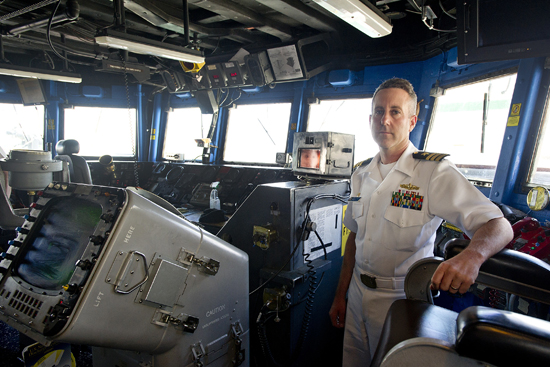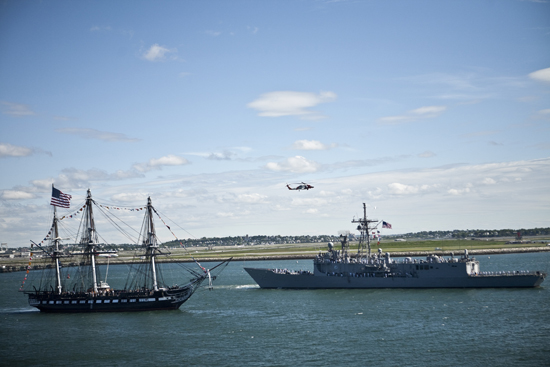In the Navy
ROTC alum commands frigate

Patrick Kulakowski is proud of his vehicle, and he recently invited nine guests from his alma mater to admire its sleek gunmetal gray lines, eye-arrestingly tapered front, massive screens and gauges, and steering knob. Yes, knob, the size of a large walnut. Amazing that something so small can turn a 453-foot ship with a displacement of 4,000 tons.
Kulakowski’s pride and joy is not a car, but a Carr—the USS Carr to be exact—a naval frigate that spent the first weekend of June berthed in Boston. The BU staffers—Naval Reserve Officer Training Corps leaders, professors invited by NROTC students they’d taught, and 21-year Navy veteran Jeffrey Hutter, dean of the Goldman School of Dental Medicine—toured the Carr, commanded by Kulakowski (ENG’92), an alum of the University’s NROTC program.
Guided by the ship’s executive officer, the group weaved through narrow halls, stepped through oval doorways with sills almost a foot high, climbed stairs so steep they’re more like ladders, filed past armed sailors in fatigues at attention, and viewed one of the bays for the ship’s two helicopters. (With the choppers temporarily on shore, the bay had been turned into a temporary gym.) Afterward, the ship’s commander debriefed the guests in his stateroom, whose faded blue wallpaper “will make you sick,” he confided.
Some may daydream about returning to campus in a shiny Corvette or BMW, mused Douglas Sears, a BU associate vice president and director of military education. “The idea of pulling up at the wheel of a big gray Navy warship takes cool to a whole other dimension. I’m kind of jealous.” No wonder: no Corvette or BMW boasts a 76-millimeter gun, torpedoes, and those two armed helicopters, among other weaponry.
It’s the first command for Kulakowski, who took over the Carr and its crew of 200 last October. A native of Peabody, Mass., he grabbed the chance to make a brief visit home ahead of a deployment to the Baltic next month. A wiry 40-year-old with close-cropped gray hair, he still drops his r’s when speaking, resulting in some kidding from his far-flung college peers: “I still remember at BU being told I had an accent. It’s my city!”
Kulakowski didn’t have a natural affinity for the water when he joined the Navy, influenced by his father, a Navy petty officer who served in Vietnam. He’d never sailed until BU, where NROTC’s mandatory sailing class put him on the Charles. That’s just one of many ways he was well prepared for his career by the University and its NROTC program, he says, which last year had 102 participants. The number for the Army ROTC was 114, for the Air Force 54.
Combining NROTC and studies “was really tough, but I think being an engineer and doing ROTC prepared me for this job,” he says. “I did take an extra six months to graduate because of the requirements. The BU curriculum was challenging,” and he drilled with NROTC two to three days a week, “usually at zero-600 down at the old armory on Commonwealth Ave.,” now the site of Agganis Arena.
No land vehicle can match the Carr’s impressive specs. When deployed, her rations include 1,850 dozen eggs, more than a ton and a half each of ground beef and steaks, 1,200 gallons of milk, 1,000 pounds of lettuce, and 242 cans of tomatoes.
Kulakowski walks briskly and familiarly around this floating arsenal-cum-amenities, although he confesses that it took three weeks before he had the layout down.
The biggest challenge of command? Maintaining an old ship, he said. The Carr, built in the early 1980s, is part of the Navy’s aging frigate fleet and is scheduled to be decommissioned in 2013. His time at sea is also challenging for his wife and four children, ages two to six, who live in Virginia, “but I think they’ve gotten used to that,” he adds.
The greatest joy? “Definitely the sailors, interacting with them. These guys are 18, 19, 21. The amount of work they do is incredible. I talk to friends in business; I just don’t think they expect as much from their 19-to-21-year-olds as we do.”
Kulakowski has fond memories of college, and says he never encountered any antimilitary sentiment while walking around campus in uniform. “My crew had some concerns coming up to the Northeast. A couple talked to me and said, ‘They’re not supportive of the military.’ I said, ‘Not at all. I don’t know where you get that view from.’” But as a New Englander he does stand out on board—most of his sailors hail from California, Texas, New York, and the Midwest, he said.
For all the firepower at his command, Kulakowski said, “We don’t really shoot down a lot of aircraft. We don’t sink a lot of subs or blow up other ships. The thing we really do day to day is interact with partners, work with different navies down in South America, the Sixth Fleet, NATO, the African nations.”
He asked the group gathered in his stateroom following the tour for feedback: “Any thoughts?”
“Brings back for me personally great memories,” said Hutter, who reminisced about his years shipboard and the now-obsolete skill of navigating by stars and sextant. “That was one of the hardest classes at BU,” said Kulakowski; he recalled professors like Michael Corgan, still a College of Arts & Sciences international relations associate professor. “Was Mike Field around when you were here?” Sears asked. “He was my second commanding officer,” Kulakowski replied. “Flew F-14s, I think.” Field retired, Sears informed him, and obtained a doctorate.
As a thank-you for the tour, the group gave Kulakowski a pair of baseball caps, from NROTC and SDM. “We’re really proud to know you’re here,” said Captain Curtis Stevens, a professor in BU’s Division of Military Education.
Hutter agreed: “It does mean a great deal to have an alumnus as commander of a combatant ship.”
Rich Barlow can be reached at barlowr@bu.edu.

Comments & Discussion
Boston University moderates comments to facilitate an informed, substantive, civil conversation. Abusive, profane, self-promotional, misleading, incoherent or off-topic comments will be rejected. Moderators are staffed during regular business hours (EST) and can only accept comments written in English. Statistics or facts must include a citation or a link to the citation.